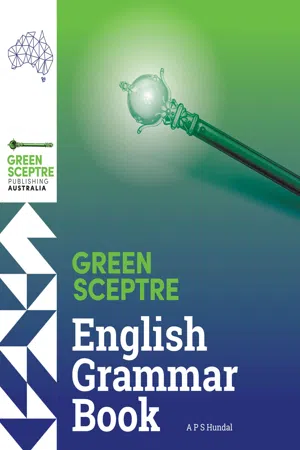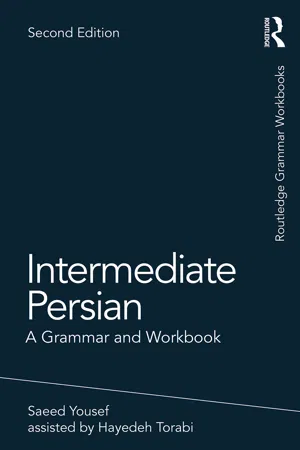Correlative Conjunctions
Correlative conjunctions are pairs of conjunctions that work together to join words, phrases, or clauses in a sentence. Common examples include "either...or," "neither...nor," "both...and," and "not only...but also." These conjunctions are used to show a relationship between two elements in a sentence and are important for creating balanced and parallel structures.
4 Key excerpts on "Correlative Conjunctions"
- eBook - ePub
- APS Hundal(Author)
- 2022(Publication Date)
- Green Sceptre Publishing Australia(Publisher)
...Each member of the pair is used before phrases or words to join them. The phrases or words joined by Correlative Conjunctions have same functional value. Below are few Correlative Conjunctions: LIST OF Correlative Conjunctions Either…or Not…only Whether…or Neither…nor But…also Both…and Though…yet Here are few examples: He is either weak or afraid. He is neither intelligent nor strong. He not only works in a cafe but also goes to college. Whether you attend the class or I will mark you absent. Though he is weak yet he is very brave. Practice Exercise Fill following blanks with appropriate conjunctions: 1. Three…………three makes six. 2. Eliza passed…………her cousin failed. 3. I was sleeping…………Alex came. 4. You will won this match…………you work hard. 5. She went to movie…………finishing her homework. 6. …………you are intelligent, you are proud. 7. Wait…………she arrives. 8. …………you start studying or. you will not pass 9. …………she was abroad, I spoke to her father. 10. Make hay…………the sun shine. Answers 1. And 2. But 3. When 4. If 5. After 6. Although 7. Till 8. Unless 9. Since 10. While Fill following blanks with appropriate conjunctions: 1. Inder came…………gave me gift. 2. Return my gift…………I will complain to mother. 3. Do what you like;…………not at the cost of selling property. 4. Everybody die one day…………all souls are immortal. 5. Karamveer is intelligent…………Racheal is dumb. 6. The small dog was weak…………sick. 7. Ajay…………karam is proud of javan. 8. Jade…………sunita to blame. 9. Be quiet…………leave the class. 10. The bell has gone, let us start………… 11. I…………reached home, it was raining. 12. He pressed the brakes…………the truck didn’t stop. 13. I know…………he is. handsome. 14. Always lock your car…………you park. 15. …………you sow, so shall you reap....
- eBook - ePub
A Sentence Diagramming Primer
The Reed & Kellogg System Step-By-Step
- Dr. Judith Coats(Author)
- 2017(Publication Date)
- Page Publishing, Inc.(Publisher)
...Conjunctions: The Three Types Are Coordinating, Subordinating, and Correlative Grammatical explanation. Coordinating conjunctions join grammatical equivalents (green and white, green or white, green yet white), subordinating conjunctions make one clause dependent on the other (since she wore green, she cheered for the other team), and Correlative Conjunctions work in pairs but still join grammatical equivalents (not only green but also white, whether green or white, both green and white). Diagramming explanation. Conjunctions will be placed on dotted lines because they are joining words. So the lines on which they are diagrammed are broken because they simply function to join groups of words, phrases, or clauses. So there will be intervening words before and after the conjunctions—thus the broken lines. The following is a sample sentence for Correlative Conjunctions: Note that we’ll wait just a bit to demonstrate the subordinating conjunction until after we introduce the concept of diagramming multiple clauses in one sentence....
- eBook - ePub
- Jack Umstatter(Author)
- 2010(Publication Date)
- Jossey-Bass(Publisher)
...Similarly, in the sentence, “You can swim or jog during the afternoon class,” the conjunction or joins the two verbs swim and jog. A coordinating conjunction is a single connecting word. The seven coordinating conjunctions are for, and, nor, but, or, yet, and so. An easy way to remember these seven conjunctions is the acronym FANBOYS, in which the first letter of each conjunction is used. Activity Underline the coordinating conjunction in each of these sentences. I will not be able to go to the field for I have not completed my science project. Paola would like to be here with us, yet she has to watch over her younger sisters today. This seems like a terrific plan, but I am not sure that the town can afford such a high tab. Perhaps you or your neighbors will be able to organize the block party this year. Do you think that we should put the paint on now so it will have time to dry? 16 the correlative conjunction Just as the coordinating conjunction does, the correlative conjunction joins words or groups of words. Here are the five pairs of Correlative Conjunctions. Whether... or Neither... nor Both... and Either... or Not only.....
- eBook - ePub
Intermediate Persian
A Grammar and Workbook
- Saeed Yousef, Hayedeh Torabi(Authors)
- 2021(Publication Date)
- Routledge(Publisher)
...UNIT TWELVE فصل ١٢ Correlative Conjunctionstions More on subordinate clauses A review of tā حرف ربط هایِ پیوسته باز هم جملات تبعی “مرورِ “تا 12.1 Correlative Conjunctions Correlative (or reciprocating) conjunctions work in pairs, usually joining words (or groups of words) that are of equal weight. If the sentence has only one main verb, it is usually placed before the second part of these conjunctions; using a comma to separate the two parts is optional. From the following list, you already know the first two (see 4.7): خواه … خواه [ khāh … khāh …] and … چه … چه [ che … che …] both mean “whether … or …”:.من خواهم رفت، چه تو بیائی چه نیائی (I’ll go, whether you come or you don’t.).باید آن را بخوانی، خواه خوشت بیاید خواه نه (You must read it, whether you like it or not.) On the basis of this “khāh … khāh …” conjunction (from the verb خواستن), Persian has the common adverbs خواه ناخواه (khāh-nā-khāh, willy-nilly, whether desired or not, no matter what) or خواهینخواهی (khāhi-nakhāhi, same meaning):.خواهی نخواهی یک روز میفهمد (One day he will find out, whether you like it or not.) یا … یا (yā … yā …) means “either … or …”:.یا امروز میآید یا فردا (She comes either today or tomorrow.).یا درس بخوان یا به مادرت کمک کن (Either s tudy, or help your mom.) نه … نه...



